Carnival Societies
Posted on 21 April 2020
In the middle of the 19th century, the first Great “Sociedade Carnavalesca” freely translated to Carnival Societies, an entertainment association founded by revelers from the high society in Brazil, paraded at the streets of Rio de Janeiro. This type of carnival demonstration became the main the carnival activity of Rio de Janeiro, taking the place of “entrudos" (violent and crude game that took place on the streets, a tradition brought from Europe), which we will discuss on another opportunity. But what exactly were the Carnival Societies? This is what we will explain below.
The first movements towards the emergence of carnival societies took place in Rio de Janeiro, in the late 1830's. It was around this time that Rio's elites began to copy the carnival that was taking place in Paris, seeking to move away from the well-known set of games with Entrudo.
Attempts to civilize the Carioca Carnival
With the move of the Portuguese court to Rio de Janeiro, the first attempts to “civilize” this carnivalesque party appeared, through the import of Parisian masquerade balls. Thus, the “Popular Entrudo” started to suffer strong police control. Several prohibitions were imposed from 1830, in an always fruitless attempt to end this gigantic and spontaneous manifestation of the people.
The French model caused the fashion of Masquerade Balls, Fantasy Balls or Bals Masqués to be quickly copied by the Court.
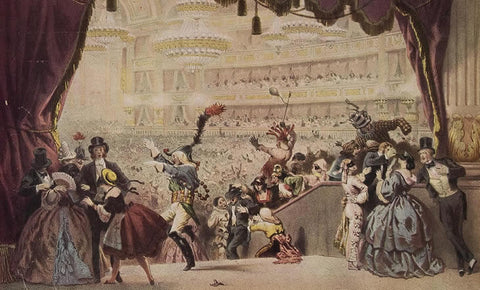
Above at Largo do Rocio, also in Rio, the country's first carnival ball was held. The year was 1840 and the idea was of an Italian woman, who missed her country, wanted to bring some elements of the Venice Carnival. There was confetti, streamer, mask ...
Gradually the act of moving from the houses (even the ballrooms was becoming an event in itself) or from the headquarters of the societies (the name given to groups that met for meetings and gatherings) to the streets was becoming more evident .
Parading through the city in open carriages, showing the population the rich costumes imported from Paris would become one of the great pleasures of the bourgeoisie during the carnival days.
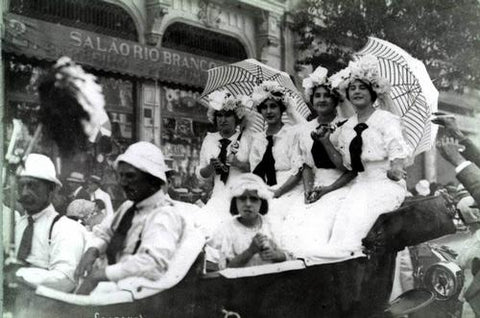
Rio societies were identified with the economic elite and tried to copy the carnival models of Venice and Paris as we see below. Characters such as the Colombian, Pierrot and King Momo were also incorporated into the Brazilian carnival, although they are of European origin.
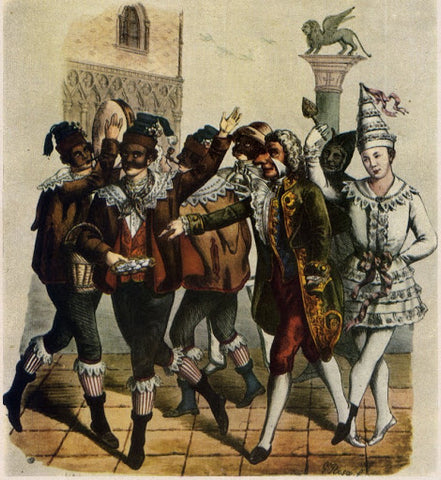
The people of Rio de Janeiro watched the passage of these costumed groups with great interest, saluting their passage as they were used to, that is, throwing their scented lemons on them. To avoid this confrontation, the tours were increasingly organized in veritable training.
That same year, a group of elite revelers decided to form a social and entertainment club for its members, called "Congresso das Sumidades Carnavalescas" holding its first parade through the streets of Rio de Janeiro.
It would not be a mere journey between the houses and the balls, but an event that would suffice itself, along the lines of what was done in Paris, Rome or Nice.
The great publicity of the event marked an era and produced a founding event for Brazilian carnival; the famous parade of the Congress of Sumptuous Carnivals, considered by historians as the first Brazilian "Carnival Society". However, there was also another group from the same time, called União Veneziana (Venetian Union).
The idea behind the societies was an attempt to reproduce the party inspired by the Carnival from Venice. Its inaugural parade took place in that same year, with members of Brazilian high society dressed in Cossack's from Ukraine, Scottish clarions, Don Quixote, mandarins, nobles from the Caucasus, Fernando, the Catholic, among other luxurious European-inspired fantasies.
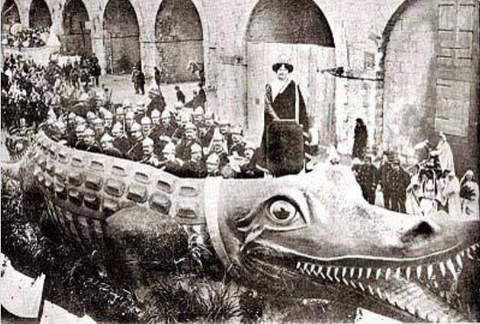
Above a float from 1855 from "Congresso das Sumidades Carnavalescas".
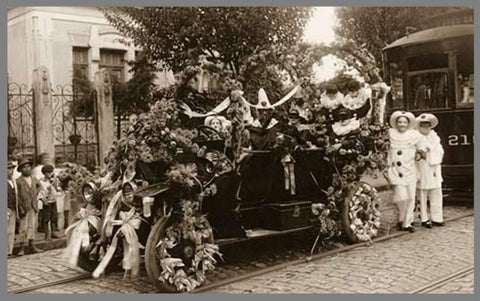
The club members were part of the Brazilian elite and took to the streets dressed in the most diverse themes following the luxurious European-style fantasies. One of the founders of this club was José de Alencar, author of the famous book and novel "O Guaraní".
But when did the carnival societies became "legal" to parade on the streets of Rio and who were the 1st organized carnival groups? There are controversies about pioneering.
One of the chains says that, in 1848, the famous Zé Pereira (we will discuss him on a later Blog) decided to pick up his kick drum and go out and play in the streets in 1848. People thought it was cool and started following him, giving rise to the blocks, others say that the first was the Congress of Sumptuous Carnivals, founded in 1855 by the writer José de Alencar. The parade was formed by a commission of intellectuals, and was authorized by Emperor Dom Pedro II, who would even have attended it.
“Long live Carnival, fine, chic and polite”
The battle cry defined the spirit of the Emerald Society in relation to the celebration. Carnival born in the slave quarters that the era was the most lowly, now enters like a Morpheus in the elite salons. The year is 1873. The two big carnival societies in Porto Alegre appear: Esmeralda and Venezianos as we will explain below.
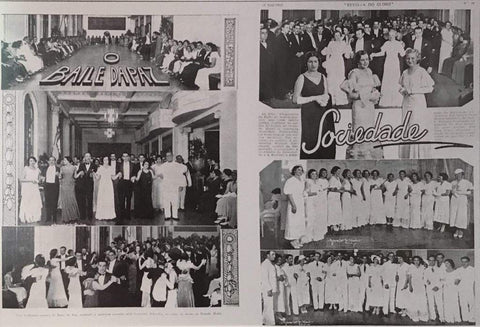
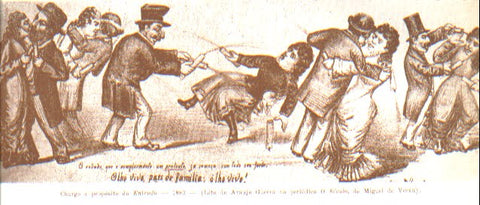
Above, the carnival of Porto Alegre, in the year 1882, Jornal do Commercio, in the column "Folhaetim", portraying the ball carnival society Esmeralda.
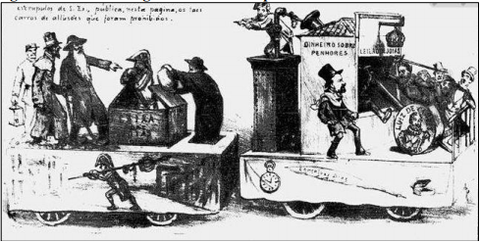
Above, floats from Carnival Societies 1883, from the magazine Revista Illustrada, ano 8 n.331.
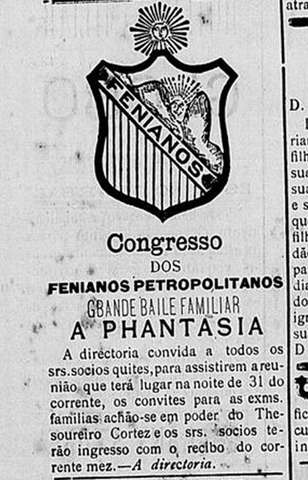
Above, the symbol/logo of the Fenianos Society Club from Petrópolis, Rio de Janeiro. In the newspaper clip, they are asking the founding members to gather on a specific date.
The fact is that the Rio de Janeiro police only authorized the parade of blocks through the streets in 1889.
In the year following parade, the Brazilian Emperor Peter II, left the Imperial Palace of Quinta da Boa Vista, to watch the parade, which passed through the streets of the city center, and entered “Largo do Paço” amid great acclaim.
In the war between the popular entrudo, of Portuguese origin, and the elite and French Carnival of Rio de Janeiro in the mid-19th century, the victory of the latter began to happen when the first parades of floats took place, with the vehicles in use, such as the couldron, the saloon and the coupe, richly decorated, decorated and packed with revelers. However, the first floats in the city of Rio de Janeiro were built and paraded through the central streets of the city in 1786 by order of the viceroy Luís de Vasconcelos to commemorate the wedding celebrations of the king of Portugal.
In the middle of the 19th century, the parades of floats marked the rise of masks and fantasies about syringes, smelly pots of water, from the old entrudos that, however, resisted until the end of the century.

Carnival dances, like the famous ball at Teatro São Pedro, were animated with the presence of more than 5,000 dressed and masked revelers, some with luxury and elegance. The carnival's golden key was the parade of masked revelers in the floats, accompanied by music bands, through the streets of the Center and the Passeio Público in Rio de Janeiro.
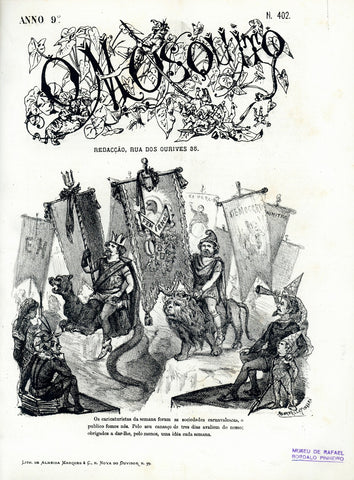
Above, an illustration from Bordalo Pinheiro, February 17th, 1877, mentioning the carnival society Democráticos, Zé Pereira.
The "Great Societies" promoted parades in the city with their members in full costumes.

In an edition of the Gazeta Mercantil newspaper of 1855, the writer José de Alencar, founding partner of “Sumidades Carnavalescas” wrote that during carnival Monday, instead of strolling through the streets of the city, the masked “Sumitians” (name of the revelers from Sumidades Carnavalescas) would gather at the one of Rio’s main street and there they would spend an afternoon in the same way as a carnival afternoon in Italy, throwing confetti, handing out flowers and intriguing bystanders with their masks and friends.
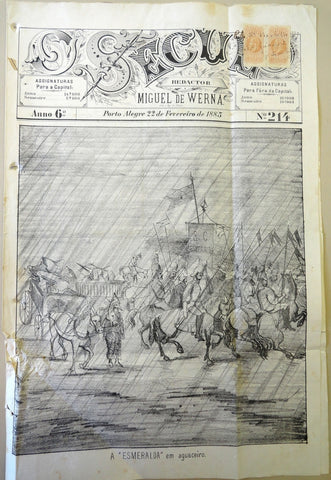
Above a illustrated newspaper from 1885, note how interesting they narrate the parade below. They talk about two "carnival society" groups, one called Venetian and the other Germania from Porto Alegre, Rio Grande do Sul.
"The year was 1885, on a carnival Tuesday in Porto Alegre. Germania had already presented its service the previous day. The Venetians did not take to the streets that year. But Esmeralda promised to come with all the pomp and shine, only ...
"The rain deprived the population of enjoying the beautiful tour prepared by the Esmeralda society.
All the partners were already dressed up and the cars of triumph in order to follow, when a torrential rain put everything in disarray, causing great damage in costumes, painting and so on.
The grief was general, because the "Esmeraldinos" promised a splendid feast.
The public, however, had the opportunity to see the magnificent triumphant cars, which would have the following order:
1st - Queen's car, a large rose floating in the sea, between foam flakes, and taken by four swans, guided by cupids. The beautiful queen would rise from the center of the flower, surrounded by a large court.
This car was in charge of Mr. Alfredo Chaves.
2º - Bohemian tent, richly adorned and with two huge dragons in front, guarding the figure of Minerva. The bohemian would be represented by an interesting girl, accompanied by several groups, arranged with great pleasure. The execution was by Mr. Leopoldo Masson.
3rd Car from America. In the center, on a golden throne, a young gallant would represent America, with the busts of Colombo and Américo Vespúcio beside it.
Other young women would represent Brazil and Industry. Two buggers, guarding the Maltese cross, would complete the allegory, which, as can be seen, would arouse the greatest enthusiasm.
All the work of the American car was entrusted to Mr. Araújo Guerra [...] ". (The Federation, February 18, 1885)
Other clubs emerged and organized sumptuous balls and parades through the streets, which gave new aspects to the emerging Rio Carnival. For years, the main stars of the parades of the great traditional societies were the “Clube Democraticos” (founded 1877), “Clube dos Fenianos” (founded 1869) and “Tenentes do Diabo” (founded 1855). The “great societies” paraded from the middle of the 19th century all the way to the 1950’s, but by the 1930’s, they were already on their decline. The ´Carnival Societies´, were highly organized and had their own logo, statute, and division of responsibilities among its members, as we can see below. José de Alencar also stated that the club already had almost 80 members.

Above we see men riding their horses, very typical at the carnival societies, specially at rural rich areas.

Society woman parading through the beach avenues of Rio, with the Sugar Loaf as a backdrop.
Below we see a statute of the “Tenentes do Diabo”.
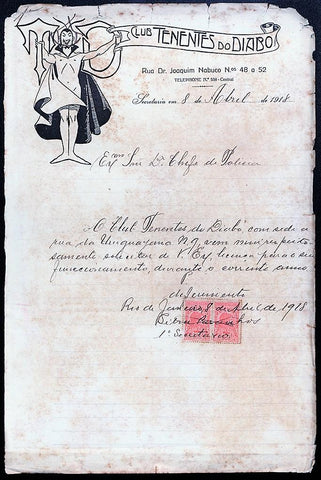
Apart from Rio, Carnival historians were able to document the existence of Carnival Societies in five other cities: São Paulo, Recife, Florianópolis, Porto Alegre, and Salvador. This shows that the Carnival Societies were a national phenomenon.
Floats were part of the parades of the Great Societies
The tradition of presenting floats goes back well before the emergence of the Samba Schools and can be credited to these associations. As we will be able to see through the photos, the “Great Societies” were among the first carnival expression in Brazil to use Floats on their parades. Back then, the floats were obviously much more primitive, but were made with great care.

We can see that, the car that seems to be an allegory of watermelon was pulled by donkeys, a usual fact at that time, as seen in other photos. A beautiful brunet as described at the time was inside, in the center of the float.

Above, on the left side, a float from Tenentes do Diabo, at the carnival of 1913. A float named "Five o clock Tea".The Lieutenants together with the Democrats and Fenianos were for years the biggest stars of the parades of the "Great Societies".
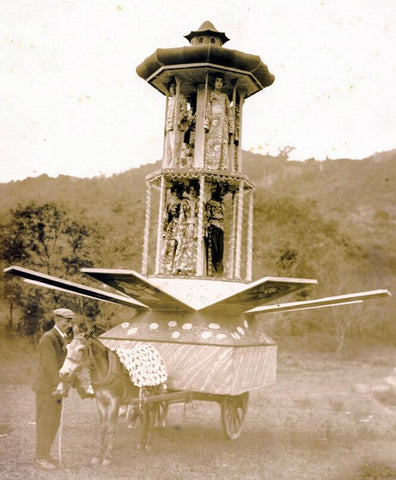
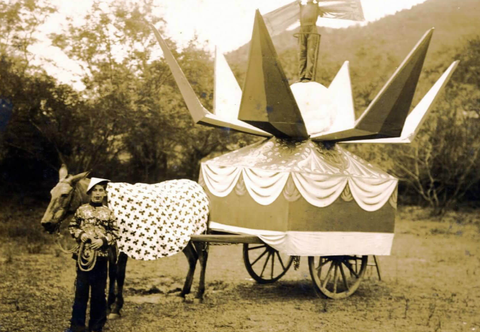
A horse and its float, circa 1920.
Below, in the photo on the left, we can see the Fenianos float at the ancient and distant carnival of 1913, practically 100 years ago, presenting an allegory in the form of a lyre ("A Lira de Sapho"), apparently prepared with great care, with some members of the club on the car.

Another aspect that was much explored in relation to the theme of floats, were the allegories with satires to the governments, which were always present in the parades of the "big societies". In the photo below, on the right side a float from the Fenianos of the 1923 carnival. As usual, the car was powered by animal traction.

We can observe that the Carnival Societies had several aspects of the modern-day era samba schools. We can list a few items on that sense. The Carnival Societies had a theme they would develop upon and they had a satirical component to this critique. The revelers would parade in costumes and the members would organize themselves to decide in conjunction parade ideas.

Above a float from the "Argonautas" societies. A beautiful float that you can see was made with much care and attention to details.
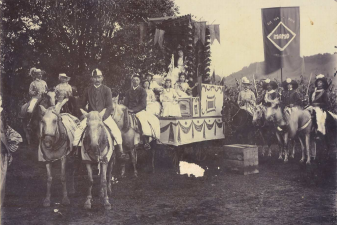
Above, a float being pulled by horse in the beginning of the century in Rio Grande do Sul.
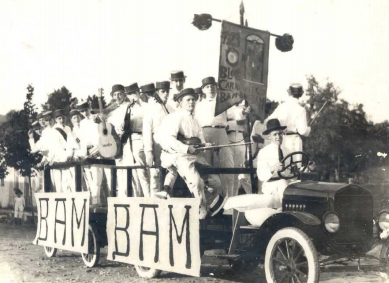
Above the Bam-Bam society group exclusively for men in 1925, Santa Catarina, Rio Grande do Sul.

A "society" parade circa 1920 at Santa Cruz do Sul, Rio Grande do Sul. Notice the horse floats.
Finally, the Carnival Societies were also the first organized carnival association to build carnival floats to help to describe the parade idea. Because of these elements, and many other as described above, we can conclude that the Carnival Societies greatly inspired the format of the robust samba schools we see today all over Brazil.
We hope you enjoyed our brief history of the emergence of Brazilian Carnival. Please comment and share with your friends.






